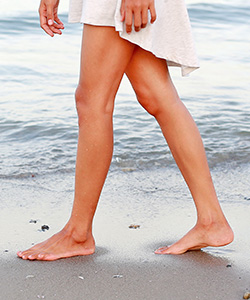
Janice Hong Messier, MD, FACS Board Certified, General Surgery Board Certified, Vascular Surgery
Almost everyone wants healthy legs that feel as good as they look. The most common health problems associated with one’s legs are circulatory. Arteries and veins comprise the leg’s circulatory system. Arteries carry oxygen-rich blood from your heart to the rest of your body and veins return oxygen-poor blood back to your heart.
Varicose veins are ropy, large and twisting veins that appear in the skin anywhere from the thigh to the foot. They are usually the result of leaking and incompetent valves in the superficial venous system.
Left untreated, these varicose veins can worsen over time. Aching, swelling of the legs along with skin changes like redness, rashes and sores can be due to varicose veins. Standing or sitting too long can worsen your symptoms.
Severe varicose veins can sometimes contribute toward phlebitis, where one or more of these superficial veins develops a blood clot. There is also a slightly increased, albeit not as common, chance of developing a deep vein thrombosis with severe varicosities. Common risk factors associated with varicose veins are smoking, genes, excess weight, trauma, pregnancy and gender.
Treatment begins with methods that do not always require surgery. Elevation of your legs above the heart two or three times a day for 15-20 minutes at a time is a great way to start. Exercise improves circulation, leading to increased venous return. Taking frequent breaks when sitting or standing for prolonged periods of time and flexing your legs allows the venous pump to keep the blood moving toward your heart.

Exercise in the form of any aerobic activity will not only improve the circulation of your legs but will also aid in maintaining or losing weight. For moderate to severe varicose veins, graduated compression stockings can effectively treat varicose veins. To relieve pain and swelling and to prevent future venous problems, compression stockings are all that some people need.
When conservative measures are not enough, treatments to eliminate varicose veins have come a long way in the past 15 years. As opposed to vein stripping of years past, which required general anesthesia and hospitalization, current methods include minimally invasive laser ablation, microphlebectomy, and sclerotherapy. Endovenous laser ablation and its adjuvant treatments are far less traumatic and more accurate with ultrasound allowing the determination and treatment of the exact problem. These more modern treatments are performed in a physician’s office, with no need for hospitalization. Equally important is the fact that insurance companies pay for many of these medical procedures, with the exception of spider veins.

